The 50-year-old statue of Soviet leader Vladimir Lenin was removed quietly this week, with images surfacing over the weekend showing the statue lying flat on the ground after being dismantled by crane. While the removal echoes a broader trend among former Soviet republics to reshape their identities away from Russian influence, local officials have suggested that the decision was primarily aesthetic.
The city’s authorities in Osh, Kyrgyzstan's second-largest city next to the capital, Bishkek, stated the statue's relocation was part of a common practice intended to enhance the city's architectural and aesthetic appeal. They referenced previous removals of Lenin statues in Russia as precedent for the action. As part of these changes, the site of the statue is set to be replaced with a flagpole, similar to the relocation of another Lenin monument in Bishkek.
This action occurs in a sensitive political landscape, as Kyrgyzstan maintains a complex relationship with Russia, its ally. Just a week prior, Russia unveiled a new statue of the controversial Soviet leader Josef Stalin in Moscow, which could complicate perceptions about Kyrgyzstan's decision to displace the Lenin statue.
Kyrgyzstan's independence 34 years ago following the Soviet Union's collapse has left a lasting legacy of Soviet architecture and nomenclature across the country; for instance, its second-tallest mountain is still named Lenin Peak. The removal of the statue may signal a continued evolution in Kyrgyz cultural identity and a reassessment of its historical symbols.
The city’s authorities in Osh, Kyrgyzstan's second-largest city next to the capital, Bishkek, stated the statue's relocation was part of a common practice intended to enhance the city's architectural and aesthetic appeal. They referenced previous removals of Lenin statues in Russia as precedent for the action. As part of these changes, the site of the statue is set to be replaced with a flagpole, similar to the relocation of another Lenin monument in Bishkek.
This action occurs in a sensitive political landscape, as Kyrgyzstan maintains a complex relationship with Russia, its ally. Just a week prior, Russia unveiled a new statue of the controversial Soviet leader Josef Stalin in Moscow, which could complicate perceptions about Kyrgyzstan's decision to displace the Lenin statue.
Kyrgyzstan's independence 34 years ago following the Soviet Union's collapse has left a lasting legacy of Soviet architecture and nomenclature across the country; for instance, its second-tallest mountain is still named Lenin Peak. The removal of the statue may signal a continued evolution in Kyrgyz cultural identity and a reassessment of its historical symbols.


















